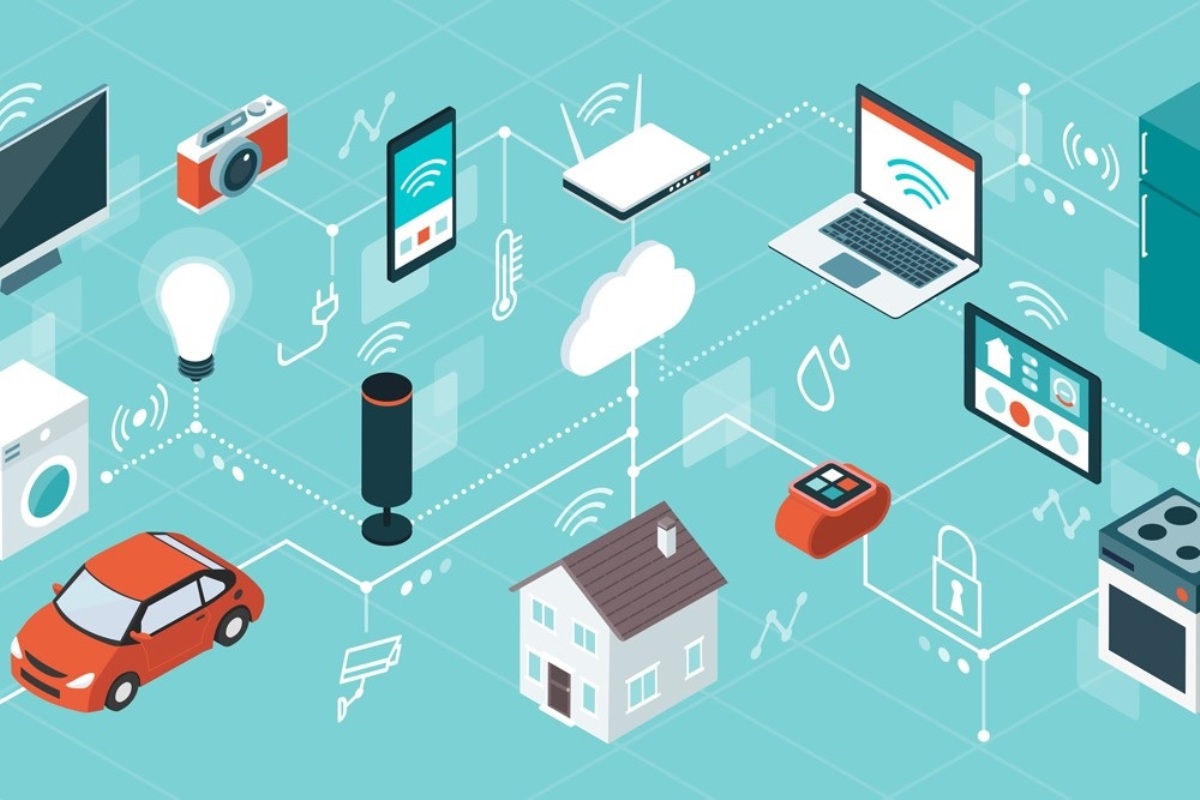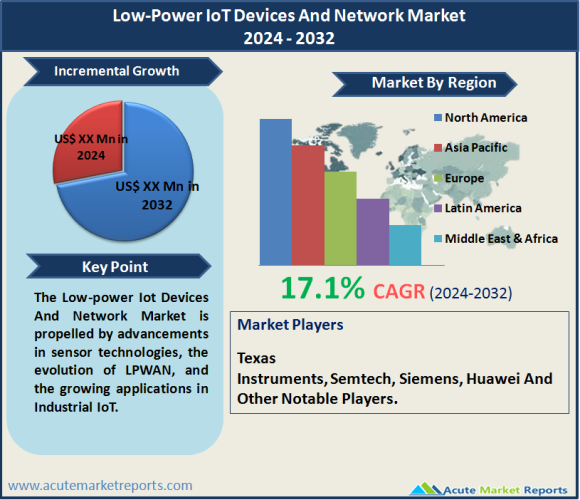
The low-power IoT devices and network market is expected to grow at a CAGR of 17.1% during the forecast period of 2024 to 2032, propelled by advancements in sensor technologies, the evolution of LPWAN, and the growing applications in Industrial IoT. However, challenges related to mesh network complexity serve as a restraint. Geographically, Asia-Pacific is expected to experience the highest CAGR, while North America remains a significant contributor to overall revenue. The competitive landscape underscores the dominance of key players and their strategic focus on innovation, connectivity, and industry-specific applications, shaping the future of low-power IoT.
Key Market Drivers
Advancements in Sensor Technologies
The market is witnessing a surge due to continuous advancements in sensor technologies. Companies like Texas Instruments and Analog Devices have been instrumental in driving innovations, enhancing the efficiency and capabilities of low-power IoT devices. These advancements enable devices to gather and process data with minimal energy consumption, catering to the demand for prolonged battery life in various applications, from healthcare to smart agriculture. The evidence lies in the deployment of these advanced sensors in real-world scenarios, showcasing their impact on device performance and energy efficiency.
Rapid Evolution of Low-power Wide Area Networks (LPWAN)
LPWAN technologies, such as LoRaWAN and NB-IoT, are emerging as key drivers for the low-power IoT devices and network market. These technologies facilitate long-range communication with low power consumption, making them ideal for widespread IoT deployments. Companies like Semtech and Huawei are leading the development and implementation of LPWAN solutions, addressing the connectivity needs of diverse industries. The evidence lies in the widespread adoption of LPWAN in smart cities and industrial IoT applications, where long-range connectivity is essential for efficient data transmission.

Growing Applications in Industrial IoT
The increasing adoption of low-power IoT devices in Industrial IoT (IIoT) is a significant driver fueling market growth. Companies like Siemens and Bosch are at the forefront of integrating low-power devices into industrial processes, optimizing efficiency and enabling predictive maintenance. The evidence is seen in the improved operational efficiency and cost savings realized by industries leveraging these IoT solutions. The integration of low-power actuators and sensors in industrial settings is transforming traditional manufacturing into smart and connected processes.
Restraint
Despite the positive momentum, the market faces a notable restraint related to the complexity of mesh networks. The deployment and maintenance of mesh networks, while offering benefits such as improved reliability and coverage, pose challenges in terms of scalability and manageability. Evidence of this restraint is observed in instances where companies like Cisco have encountered difficulties in seamlessly scaling mesh networks to accommodate the growing number of devices, leading to potential operational inefficiencies.
Market Segmentation Analysis
Market By Device: low-power IoT device Dominate the Market
In 2023, the highest revenue in the low-power IoT device market was generated by Connectivity Devices, emphasizing the crucial role of seamless communication. Simultaneously, the highest CAGR during the forecast period (2024 to 2032) was observed in the Sensors segment, showcasing the increasing demand for advanced sensing capabilities in various applications.
Market By Network Types: LPWAN Dominates the Market
In 2023, Low-power Wide Area Networks (LPWAN) dominated both in revenue and CAGR, highlighting their pivotal role in providing efficient, long-range connectivity. Mesh Networks exhibited the highest CAGR during the forecast period, indicating a growing preference for interconnected devices within local networks. Cellular Networks, while contributing to revenue, experienced a relatively lower CAGR.
By Industry Verticals: Industrial IoT SectorDominates the Market
In 2023, the highest revenue in the low-power IoT market across various industry verticals was observed in the Industrial IoT sector, driven by increased adoption in manufacturing processes. However, the highest CAGR during the forecast period shifted to the Smart Cities segment, reflecting the growing demand for connected infrastructure and urban development initiatives.
North America Remains as the Global Leader
The low-power IoT market's geographic trends highlight Asia-Pacific as the region with the highest CAGR, fueled by rapid industrialization and urbanization. North America, with its established IoT ecosystem, contributed the highest revenue percent. The reasons for these trends are rooted in the continuous technological advancements and early adoption of IoT solutions in North America, while Asia-Pacific benefits from a burgeoning market and government initiatives promoting IoT integration.
Market Competition to Intensify during the Forecast Period
In 2023, top players such as Texas Instruments, Semtech, Siemens, and Huawei demonstrated strong performances. Their key strategies included continuous innovation in sensor technologies, LPWAN solutions, and targeted applications in Industrial IoT. Revenues for 2023 are indicative of past achievements, while expectations for the forecast period (2024 to 2032) revolve around sustained growth and market leadership. These companies are anticipated to maintain their positions and adapt to evolving market dynamics, solidifying their roles in shaping the low-power IoT devices and network landscape.
Historical & Forecast Period
This study report represents analysis of each segment from 2022 to 2032 considering 2023 as the base year. Compounded Annual Growth Rate (CAGR) for each of the respective segments estimated for the forecast period of 2024 to 2032.
The current report comprises of quantitative market estimations for each micro market for every geographical region and qualitative market analysis such as micro and macro environment analysis, market trends, competitive intelligence, segment analysis, porters five force model, top winning strategies, top investment markets, emerging trends and technological analysis, case studies, strategic conclusions and recommendations and other key market insights.
Research Methodology
The complete research study was conducted in three phases, namely: secondary research, primary research, and expert panel review. key data point that enables the estimation of Low-Power IoT Devices And Network market are as follows:
Market forecast was performed through proprietary software that analyzes various qualitative and quantitative factors. Growth rate and CAGR were estimated through intensive secondary and primary research. Data triangulation across various data points provides accuracy across various analyzed market segments in the report. Application of both top down and bottom-up approach for validation of market estimation assures logical, methodical and mathematical consistency of the quantitative data.
| ATTRIBUTE | DETAILS |
|---|---|
| Research Period | 2022-2032 |
| Base Year | 2023 |
| Forecast Period | 2024-2032 |
| Historical Year | 2022 |
| Unit | USD Million |
| Segmentation | |
Device Types
| |
Network Types
| |
Industry Verticals
| |
|
Region Segment (2022-2032; US$ Million)
|
Key questions answered in this report